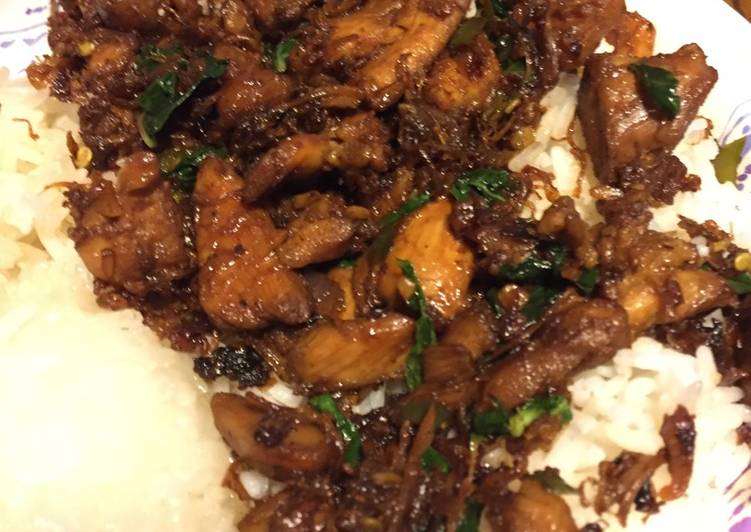Thai Basil Chicken. The sauce actually acts like a glaze as the chicken mixture cooks Whisk chicken broth, oyster sauce, soy sauce, fish sauce, white sugar, and brown sugar together in a bowl until well blended. Thai Basil tastes like normal basil with a hint of aniseed flavour. Nowadays it's fairly widely available in Australia in large grocery stores and green grocers (Coles, Woolies, Harris Farms).
 This recipe is always a big hit with the family!
It's also quite easy to make.
One of my favorite dishes at Thai restaurants is the spicy Thai basil chicken rice plate—perfectly steamed and fluffy jasmine rice coupled with ground chicken meat infused with aromatic Thai basil leaves.
You can have Thai Basil Chicken using 10 ingredients and 5 steps. Here is how you cook it.
This recipe is always a big hit with the family!
It's also quite easy to make.
One of my favorite dishes at Thai restaurants is the spicy Thai basil chicken rice plate—perfectly steamed and fluffy jasmine rice coupled with ground chicken meat infused with aromatic Thai basil leaves.
You can have Thai Basil Chicken using 10 ingredients and 5 steps. Here is how you cook it.
Ingredients of Thai Basil Chicken
- Prepare 2 tablespoons of peanut oil; divided.
- Prepare 1 lb of boneless skinless chicken thighs, chopped.
- It's 2 of shallots finely chopped.
- Prepare 4 of garlic cloves, minced.
- Prepare 3 of pounded Thai chili (green or red).
- It's 2 tablespoons of fish sauce.
- It's 2 teaspoons of dark soy sauce.
- It's 2 teaspoons of brown sugar or palm.
- Prepare 1 bunch of Thai basil leaves.
- Prepare 1/2 teaspoon of ground white pepper.
Also known as Gai Pad Krapow, this basil chicken was delicious, with a fine balance of fiery. Served along with steamed rice, it's restaurant food, fast. This Thai Basil Chicken (Gai Pad Krapow) is one of them. And it isn't one of those rush jobs either.
Thai Basil Chicken instructions
- In a large wok, heat 1 tablespoon of oil; cook chicken. Set aside on a plate when done. Do not drain.
- Reheat wok with remaining oil. Cook shallots and garlic for 3 minutes.
- Return chicken to wok and add chilies, fish sauce, soy, and sugar. Cook on high for about 8 minutes.
- Throw basil and white pepper in and cook till the basil is wilted.
- Serve over white rice. Enjoy!.
It's so quick to whip up, budget-friendly, and SO GOOD! Thai basil is a variety of basil (Ocimum basilicum) best known for its use in Asian cuisine. Unlike its cousin, Italian basil (aka Genovese basil), Thai basil has sturdy, resilient leaves that stand up well to extended cooking times. It's a bit sweeter than traditional basil, with a more pronounced floral note, and a slight licorice-y bite. Here, we combine it with a slew of aromatics and veggies (red pepper, shallots, garlic, chilies), and then infuse the.